Importance of Effective Communication and Analysis of Project Methodologies
VerifiedAdded on 2023/01/12
|13
|3157
|25
AI Summary
This document discusses the importance of effective and structured communication between the project manager and team members in order to ensure the success of a project. It also provides an analysis and critique of different methodologies that can be used to run the project case study. The document covers the Agile methodology and the Waterfall methodology, highlighting their strengths and weaknesses. Recommendations are given on the best methodology to use in the project.
Contribute Materials
Your contribution can guide someone’s learning journey. Share your
documents today.
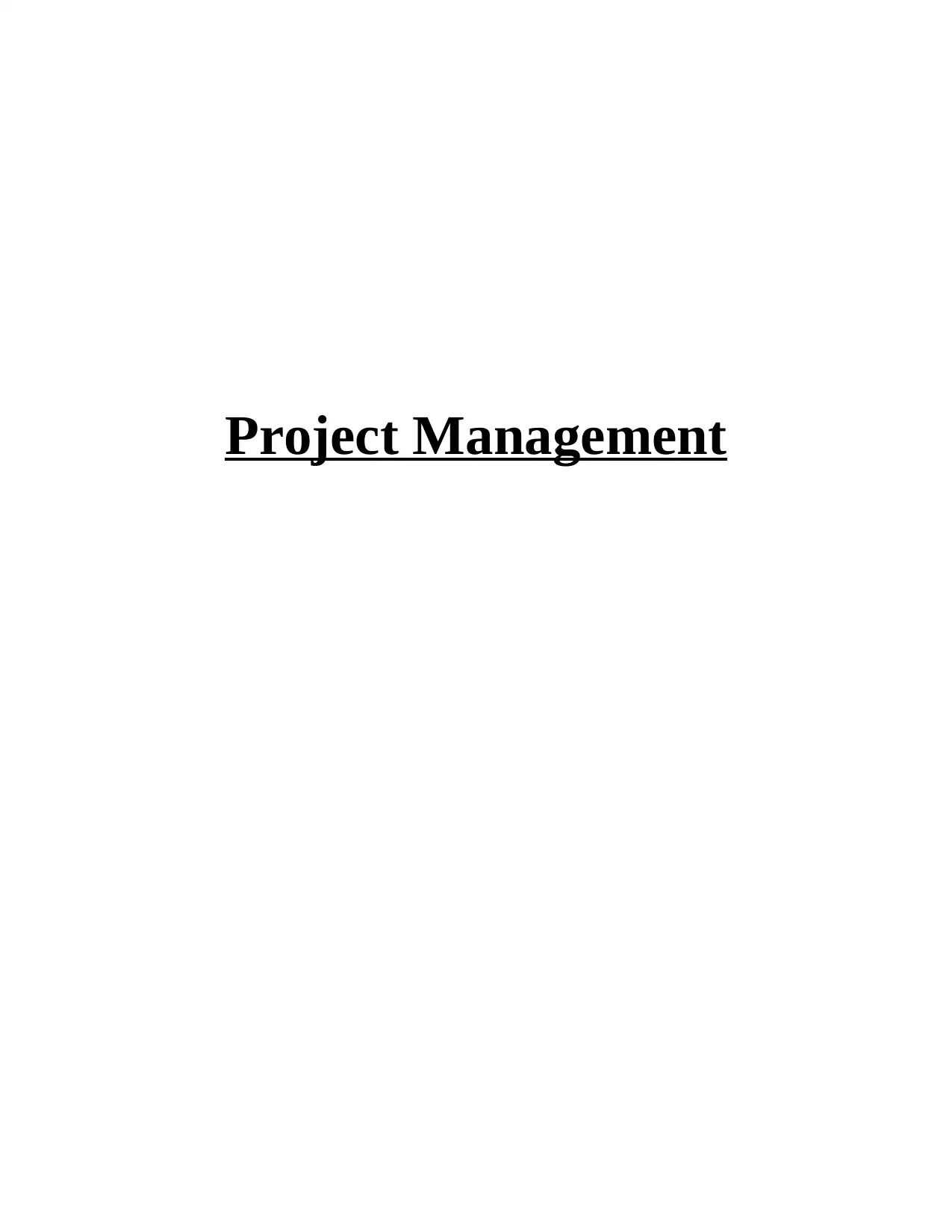
Project Management
Secure Best Marks with AI Grader
Need help grading? Try our AI Grader for instant feedback on your assignments.
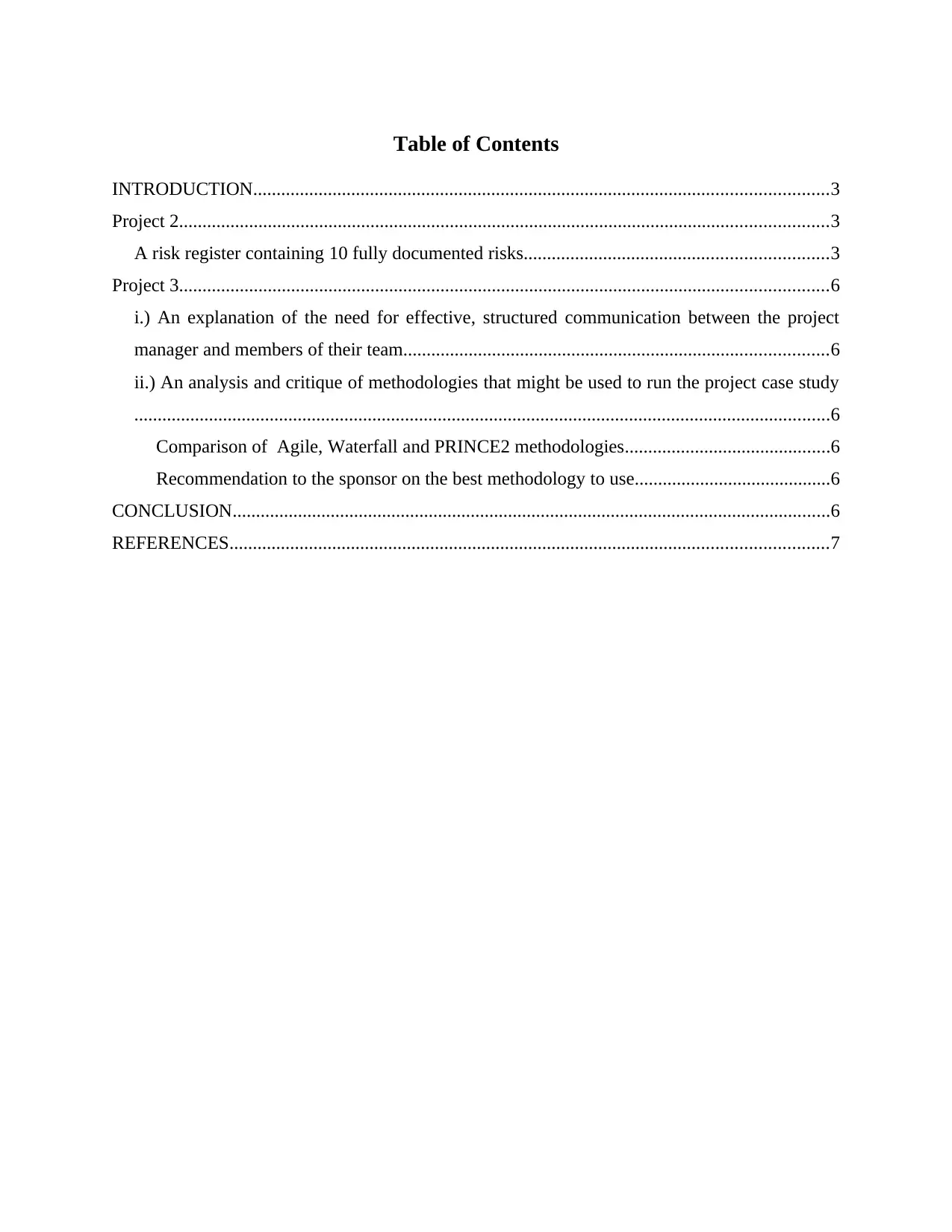
Table of Contents
INTRODUCTION...........................................................................................................................3
Project 2...........................................................................................................................................3
A risk register containing 10 fully documented risks.................................................................3
Project 3...........................................................................................................................................6
i.) An explanation of the need for effective, structured communication between the project
manager and members of their team...........................................................................................6
ii.) An analysis and critique of methodologies that might be used to run the project case study
.....................................................................................................................................................6
Comparison of Agile, Waterfall and PRINCE2 methodologies............................................6
Recommendation to the sponsor on the best methodology to use..........................................6
CONCLUSION................................................................................................................................6
REFERENCES................................................................................................................................7
INTRODUCTION...........................................................................................................................3
Project 2...........................................................................................................................................3
A risk register containing 10 fully documented risks.................................................................3
Project 3...........................................................................................................................................6
i.) An explanation of the need for effective, structured communication between the project
manager and members of their team...........................................................................................6
ii.) An analysis and critique of methodologies that might be used to run the project case study
.....................................................................................................................................................6
Comparison of Agile, Waterfall and PRINCE2 methodologies............................................6
Recommendation to the sponsor on the best methodology to use..........................................6
CONCLUSION................................................................................................................................6
REFERENCES................................................................................................................................7
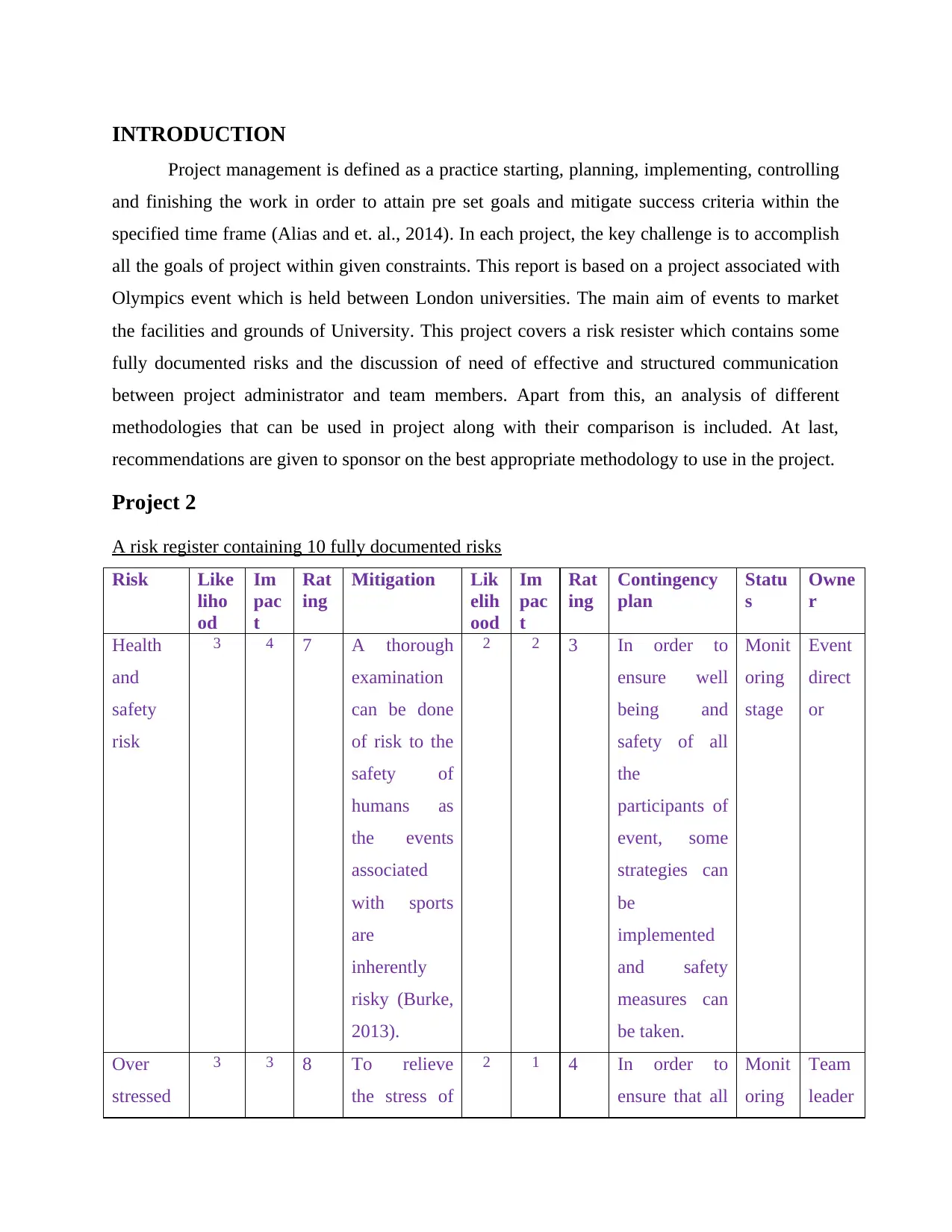
INTRODUCTION
Project management is defined as a practice starting, planning, implementing, controlling
and finishing the work in order to attain pre set goals and mitigate success criteria within the
specified time frame (Alias and et. al., 2014). In each project, the key challenge is to accomplish
all the goals of project within given constraints. This report is based on a project associated with
Olympics event which is held between London universities. The main aim of events to market
the facilities and grounds of University. This project covers a risk resister which contains some
fully documented risks and the discussion of need of effective and structured communication
between project administrator and team members. Apart from this, an analysis of different
methodologies that can be used in project along with their comparison is included. At last,
recommendations are given to sponsor on the best appropriate methodology to use in the project.
Project 2
A risk register containing 10 fully documented risks
Risk Like
liho
od
Im
pac
t
Rat
ing
Mitigation Lik
elih
ood
Im
pac
t
Rat
ing
Contingency
plan
Statu
s
Owne
r
Health
and
safety
risk
3 4 7 A thorough
examination
can be done
of risk to the
safety of
humans as
the events
associated
with sports
are
inherently
risky (Burke,
2013).
2 2 3 In order to
ensure well
being and
safety of all
the
participants of
event, some
strategies can
be
implemented
and safety
measures can
be taken.
Monit
oring
stage
Event
direct
or
Over
stressed
3 3 8 To relieve
the stress of
2 1 4 In order to
ensure that all
Monit
oring
Team
leader
Project management is defined as a practice starting, planning, implementing, controlling
and finishing the work in order to attain pre set goals and mitigate success criteria within the
specified time frame (Alias and et. al., 2014). In each project, the key challenge is to accomplish
all the goals of project within given constraints. This report is based on a project associated with
Olympics event which is held between London universities. The main aim of events to market
the facilities and grounds of University. This project covers a risk resister which contains some
fully documented risks and the discussion of need of effective and structured communication
between project administrator and team members. Apart from this, an analysis of different
methodologies that can be used in project along with their comparison is included. At last,
recommendations are given to sponsor on the best appropriate methodology to use in the project.
Project 2
A risk register containing 10 fully documented risks
Risk Like
liho
od
Im
pac
t
Rat
ing
Mitigation Lik
elih
ood
Im
pac
t
Rat
ing
Contingency
plan
Statu
s
Owne
r
Health
and
safety
risk
3 4 7 A thorough
examination
can be done
of risk to the
safety of
humans as
the events
associated
with sports
are
inherently
risky (Burke,
2013).
2 2 3 In order to
ensure well
being and
safety of all
the
participants of
event, some
strategies can
be
implemented
and safety
measures can
be taken.
Monit
oring
stage
Event
direct
or
Over
stressed
3 3 8 To relieve
the stress of
2 1 4 In order to
ensure that all
Monit
oring
Team
leader
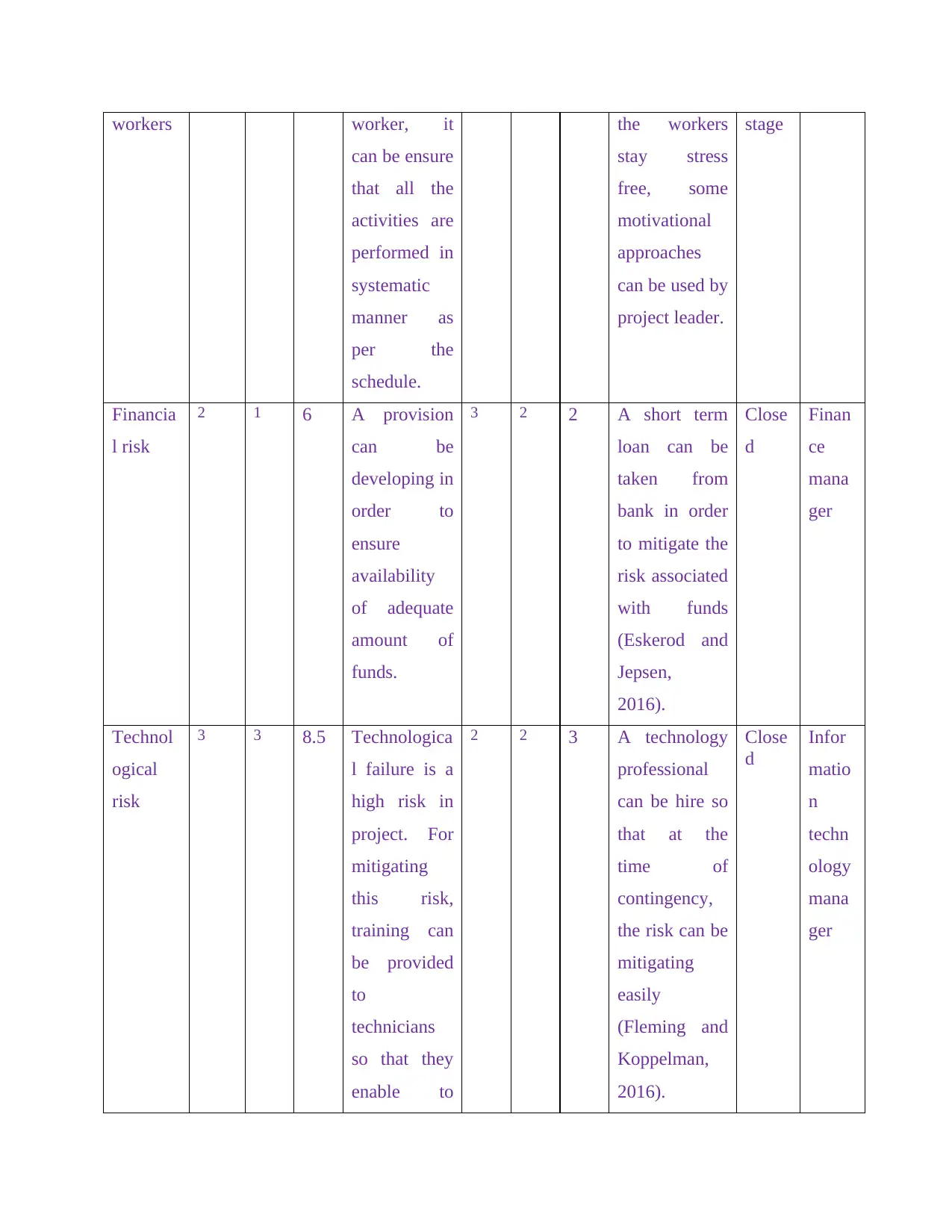
workers worker, it
can be ensure
that all the
activities are
performed in
systematic
manner as
per the
schedule.
the workers
stay stress
free, some
motivational
approaches
can be used by
project leader.
stage
Financia
l risk
2 1 6 A provision
can be
developing in
order to
ensure
availability
of adequate
amount of
funds.
3 2 2 A short term
loan can be
taken from
bank in order
to mitigate the
risk associated
with funds
(Eskerod and
Jepsen,
2016).
Close
d
Finan
ce
mana
ger
Technol
ogical
risk
3 3 8.5 Technologica
l failure is a
high risk in
project. For
mitigating
this risk,
training can
be provided
to
technicians
so that they
enable to
2 2 3 A technology
professional
can be hire so
that at the
time of
contingency,
the risk can be
mitigating
easily
(Fleming and
Koppelman,
2016).
Close
d
Infor
matio
n
techn
ology
mana
ger
can be ensure
that all the
activities are
performed in
systematic
manner as
per the
schedule.
the workers
stay stress
free, some
motivational
approaches
can be used by
project leader.
stage
Financia
l risk
2 1 6 A provision
can be
developing in
order to
ensure
availability
of adequate
amount of
funds.
3 2 2 A short term
loan can be
taken from
bank in order
to mitigate the
risk associated
with funds
(Eskerod and
Jepsen,
2016).
Close
d
Finan
ce
mana
ger
Technol
ogical
risk
3 3 8.5 Technologica
l failure is a
high risk in
project. For
mitigating
this risk,
training can
be provided
to
technicians
so that they
enable to
2 2 3 A technology
professional
can be hire so
that at the
time of
contingency,
the risk can be
mitigating
easily
(Fleming and
Koppelman,
2016).
Close
d
Infor
matio
n
techn
ology
mana
ger
Secure Best Marks with AI Grader
Need help grading? Try our AI Grader for instant feedback on your assignments.
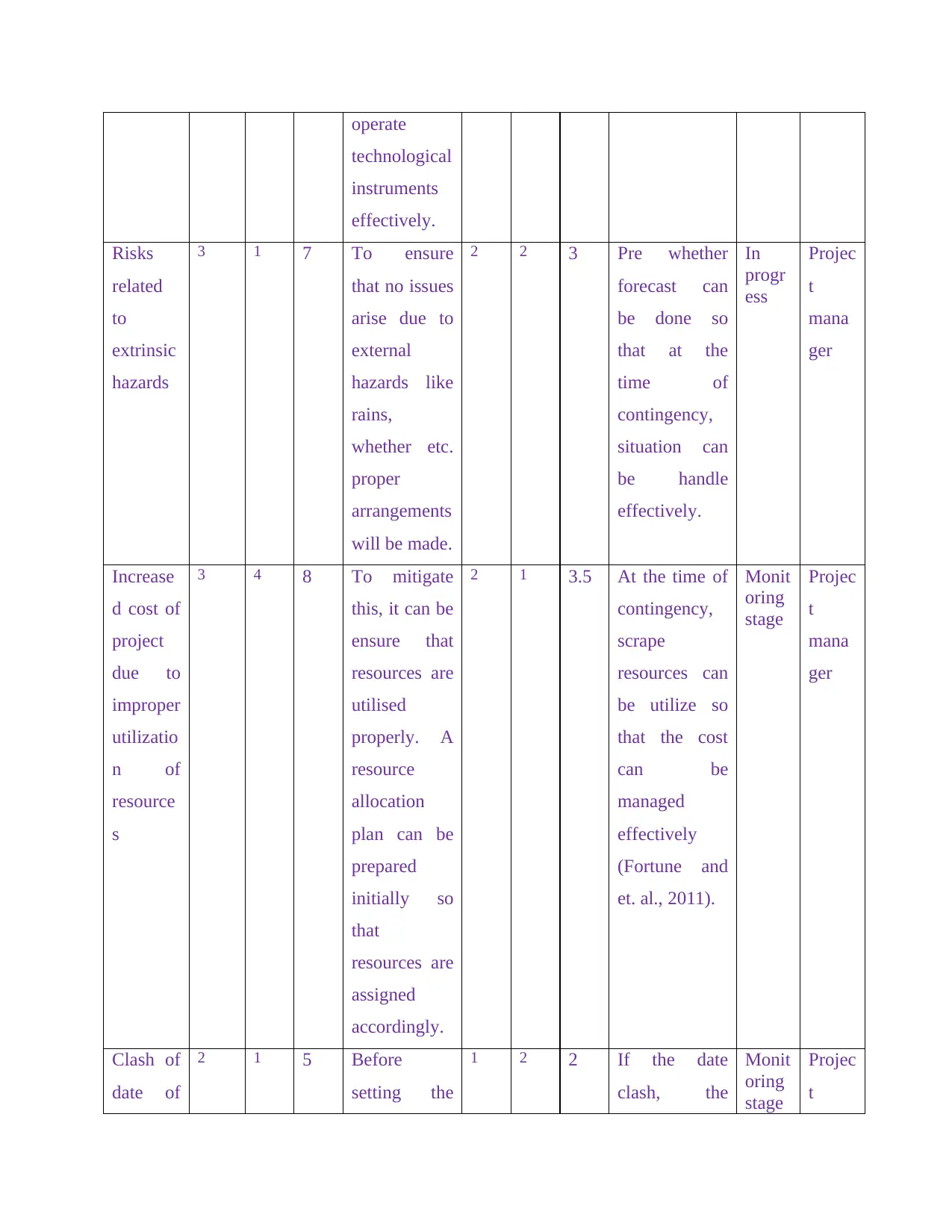
operate
technological
instruments
effectively.
Risks
related
to
extrinsic
hazards
3 1 7 To ensure
that no issues
arise due to
external
hazards like
rains,
whether etc.
proper
arrangements
will be made.
2 2 3 Pre whether
forecast can
be done so
that at the
time of
contingency,
situation can
be handle
effectively.
In
progr
ess
Projec
t
mana
ger
Increase
d cost of
project
due to
improper
utilizatio
n of
resource
s
3 4 8 To mitigate
this, it can be
ensure that
resources are
utilised
properly. A
resource
allocation
plan can be
prepared
initially so
that
resources are
assigned
accordingly.
2 1 3.5 At the time of
contingency,
scrape
resources can
be utilize so
that the cost
can be
managed
effectively
(Fortune and
et. al., 2011).
Monit
oring
stage
Projec
t
mana
ger
Clash of
date of
2 1 5 Before
setting the
1 2 2 If the date
clash, the
Monit
oring
stage
Projec
t
technological
instruments
effectively.
Risks
related
to
extrinsic
hazards
3 1 7 To ensure
that no issues
arise due to
external
hazards like
rains,
whether etc.
proper
arrangements
will be made.
2 2 3 Pre whether
forecast can
be done so
that at the
time of
contingency,
situation can
be handle
effectively.
In
progr
ess
Projec
t
mana
ger
Increase
d cost of
project
due to
improper
utilizatio
n of
resource
s
3 4 8 To mitigate
this, it can be
ensure that
resources are
utilised
properly. A
resource
allocation
plan can be
prepared
initially so
that
resources are
assigned
accordingly.
2 1 3.5 At the time of
contingency,
scrape
resources can
be utilize so
that the cost
can be
managed
effectively
(Fortune and
et. al., 2011).
Monit
oring
stage
Projec
t
mana
ger
Clash of
date of
2 1 5 Before
setting the
1 2 2 If the date
clash, the
Monit
oring
stage
Projec
t
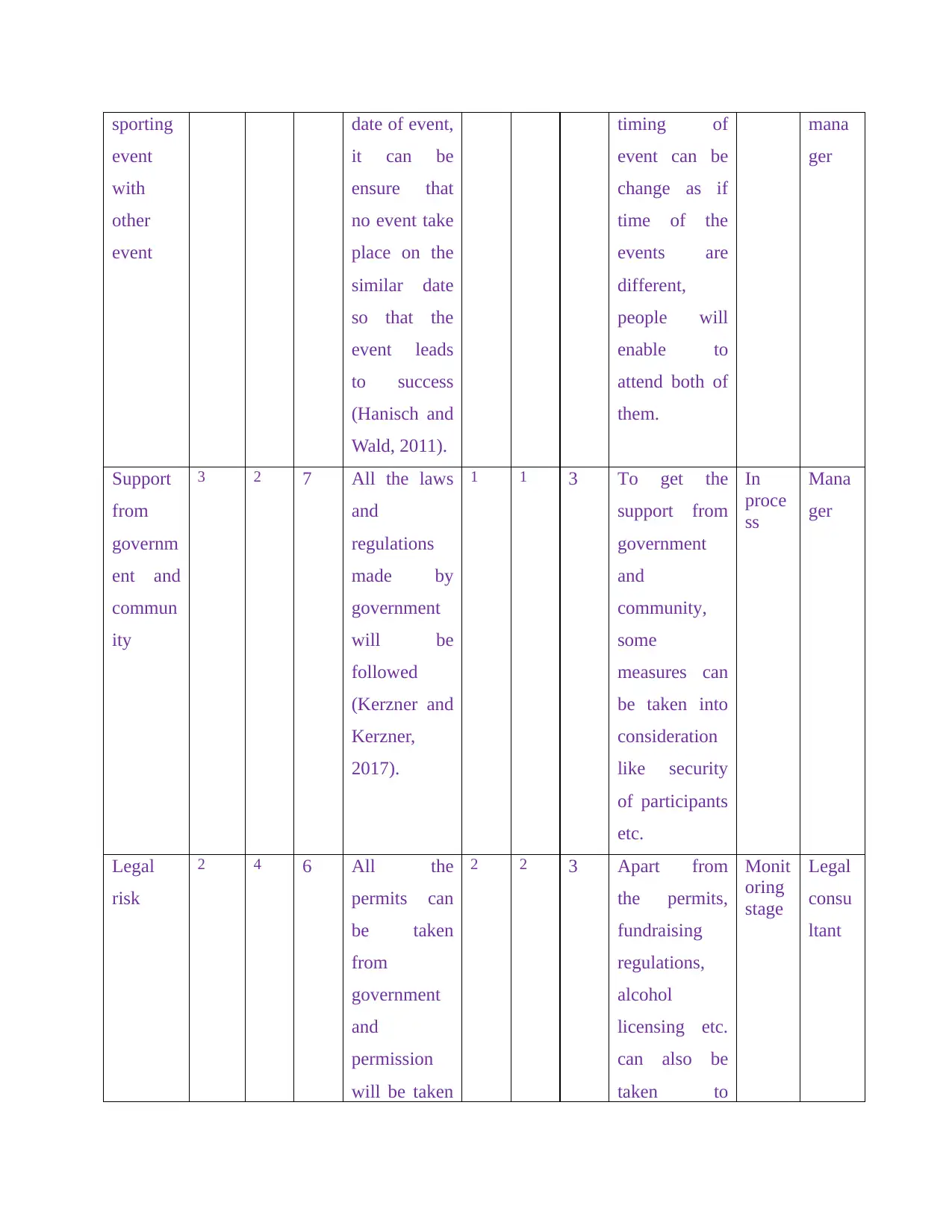
sporting
event
with
other
event
date of event,
it can be
ensure that
no event take
place on the
similar date
so that the
event leads
to success
(Hanisch and
Wald, 2011).
timing of
event can be
change as if
time of the
events are
different,
people will
enable to
attend both of
them.
mana
ger
Support
from
governm
ent and
commun
ity
3 2 7 All the laws
and
regulations
made by
government
will be
followed
(Kerzner and
Kerzner,
2017).
1 1 3 To get the
support from
government
and
community,
some
measures can
be taken into
consideration
like security
of participants
etc.
In
proce
ss
Mana
ger
Legal
risk
2 4 6 All the
permits can
be taken
from
government
and
permission
will be taken
2 2 3 Apart from
the permits,
fundraising
regulations,
alcohol
licensing etc.
can also be
taken to
Monit
oring
stage
Legal
consu
ltant
event
with
other
event
date of event,
it can be
ensure that
no event take
place on the
similar date
so that the
event leads
to success
(Hanisch and
Wald, 2011).
timing of
event can be
change as if
time of the
events are
different,
people will
enable to
attend both of
them.
mana
ger
Support
from
governm
ent and
commun
ity
3 2 7 All the laws
and
regulations
made by
government
will be
followed
(Kerzner and
Kerzner,
2017).
1 1 3 To get the
support from
government
and
community,
some
measures can
be taken into
consideration
like security
of participants
etc.
In
proce
ss
Mana
ger
Legal
risk
2 4 6 All the
permits can
be taken
from
government
and
permission
will be taken
2 2 3 Apart from
the permits,
fundraising
regulations,
alcohol
licensing etc.
can also be
taken to
Monit
oring
stage
Legal
consu
ltant
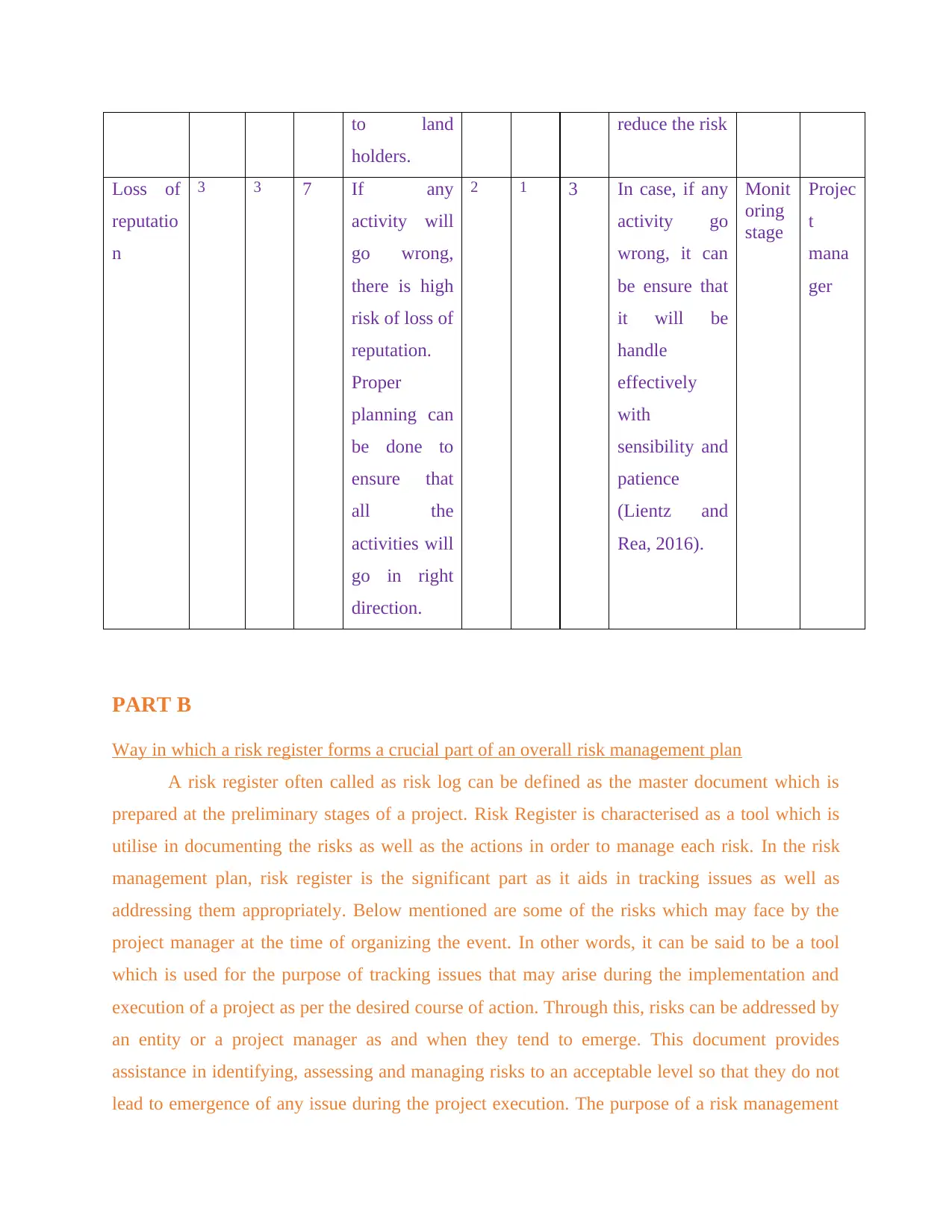
to land
holders.
reduce the risk
Loss of
reputatio
n
3 3 7 If any
activity will
go wrong,
there is high
risk of loss of
reputation.
Proper
planning can
be done to
ensure that
all the
activities will
go in right
direction.
2 1 3 In case, if any
activity go
wrong, it can
be ensure that
it will be
handle
effectively
with
sensibility and
patience
(Lientz and
Rea, 2016).
Monit
oring
stage
Projec
t
mana
ger
PART B
Way in which a risk register forms a crucial part of an overall risk management plan
A risk register often called as risk log can be defined as the master document which is
prepared at the preliminary stages of a project. Risk Register is characterised as a tool which is
utilise in documenting the risks as well as the actions in order to manage each risk. In the risk
management plan, risk register is the significant part as it aids in tracking issues as well as
addressing them appropriately. Below mentioned are some of the risks which may face by the
project manager at the time of organizing the event. In other words, it can be said to be a tool
which is used for the purpose of tracking issues that may arise during the implementation and
execution of a project as per the desired course of action. Through this, risks can be addressed by
an entity or a project manager as and when they tend to emerge. This document provides
assistance in identifying, assessing and managing risks to an acceptable level so that they do not
lead to emergence of any issue during the project execution. The purpose of a risk management
holders.
reduce the risk
Loss of
reputatio
n
3 3 7 If any
activity will
go wrong,
there is high
risk of loss of
reputation.
Proper
planning can
be done to
ensure that
all the
activities will
go in right
direction.
2 1 3 In case, if any
activity go
wrong, it can
be ensure that
it will be
handle
effectively
with
sensibility and
patience
(Lientz and
Rea, 2016).
Monit
oring
stage
Projec
t
mana
ger
PART B
Way in which a risk register forms a crucial part of an overall risk management plan
A risk register often called as risk log can be defined as the master document which is
prepared at the preliminary stages of a project. Risk Register is characterised as a tool which is
utilise in documenting the risks as well as the actions in order to manage each risk. In the risk
management plan, risk register is the significant part as it aids in tracking issues as well as
addressing them appropriately. Below mentioned are some of the risks which may face by the
project manager at the time of organizing the event. In other words, it can be said to be a tool
which is used for the purpose of tracking issues that may arise during the implementation and
execution of a project as per the desired course of action. Through this, risks can be addressed by
an entity or a project manager as and when they tend to emerge. This document provides
assistance in identifying, assessing and managing risks to an acceptable level so that they do not
lead to emergence of any issue during the project execution. The purpose of a risk management
Paraphrase This Document
Need a fresh take? Get an instant paraphrase of this document with our AI Paraphraser
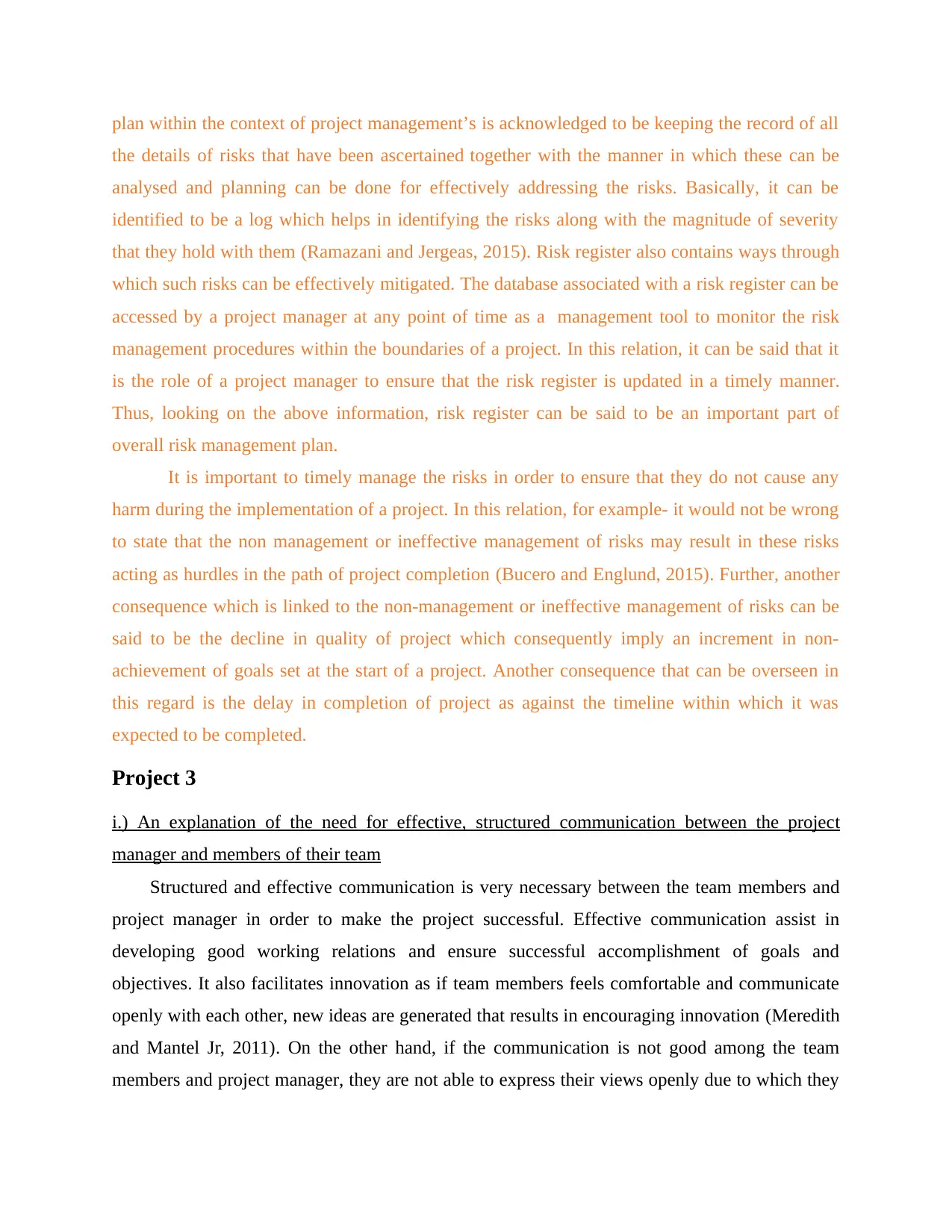
plan within the context of project management’s is acknowledged to be keeping the record of all
the details of risks that have been ascertained together with the manner in which these can be
analysed and planning can be done for effectively addressing the risks. Basically, it can be
identified to be a log which helps in identifying the risks along with the magnitude of severity
that they hold with them (Ramazani and Jergeas, 2015). Risk register also contains ways through
which such risks can be effectively mitigated. The database associated with a risk register can be
accessed by a project manager at any point of time as a management tool to monitor the risk
management procedures within the boundaries of a project. In this relation, it can be said that it
is the role of a project manager to ensure that the risk register is updated in a timely manner.
Thus, looking on the above information, risk register can be said to be an important part of
overall risk management plan.
It is important to timely manage the risks in order to ensure that they do not cause any
harm during the implementation of a project. In this relation, for example- it would not be wrong
to state that the non management or ineffective management of risks may result in these risks
acting as hurdles in the path of project completion (Bucero and Englund, 2015). Further, another
consequence which is linked to the non-management or ineffective management of risks can be
said to be the decline in quality of project which consequently imply an increment in non-
achievement of goals set at the start of a project. Another consequence that can be overseen in
this regard is the delay in completion of project as against the timeline within which it was
expected to be completed.
Project 3
i.) An explanation of the need for effective, structured communication between the project
manager and members of their team
Structured and effective communication is very necessary between the team members and
project manager in order to make the project successful. Effective communication assist in
developing good working relations and ensure successful accomplishment of goals and
objectives. It also facilitates innovation as if team members feels comfortable and communicate
openly with each other, new ideas are generated that results in encouraging innovation (Meredith
and Mantel Jr, 2011). On the other hand, if the communication is not good among the team
members and project manager, they are not able to express their views openly due to which they
the details of risks that have been ascertained together with the manner in which these can be
analysed and planning can be done for effectively addressing the risks. Basically, it can be
identified to be a log which helps in identifying the risks along with the magnitude of severity
that they hold with them (Ramazani and Jergeas, 2015). Risk register also contains ways through
which such risks can be effectively mitigated. The database associated with a risk register can be
accessed by a project manager at any point of time as a management tool to monitor the risk
management procedures within the boundaries of a project. In this relation, it can be said that it
is the role of a project manager to ensure that the risk register is updated in a timely manner.
Thus, looking on the above information, risk register can be said to be an important part of
overall risk management plan.
It is important to timely manage the risks in order to ensure that they do not cause any
harm during the implementation of a project. In this relation, for example- it would not be wrong
to state that the non management or ineffective management of risks may result in these risks
acting as hurdles in the path of project completion (Bucero and Englund, 2015). Further, another
consequence which is linked to the non-management or ineffective management of risks can be
said to be the decline in quality of project which consequently imply an increment in non-
achievement of goals set at the start of a project. Another consequence that can be overseen in
this regard is the delay in completion of project as against the timeline within which it was
expected to be completed.
Project 3
i.) An explanation of the need for effective, structured communication between the project
manager and members of their team
Structured and effective communication is very necessary between the team members and
project manager in order to make the project successful. Effective communication assist in
developing good working relations and ensure successful accomplishment of goals and
objectives. It also facilitates innovation as if team members feels comfortable and communicate
openly with each other, new ideas are generated that results in encouraging innovation (Meredith
and Mantel Jr, 2011). On the other hand, if the communication is not good among the team
members and project manager, they are not able to express their views openly due to which they
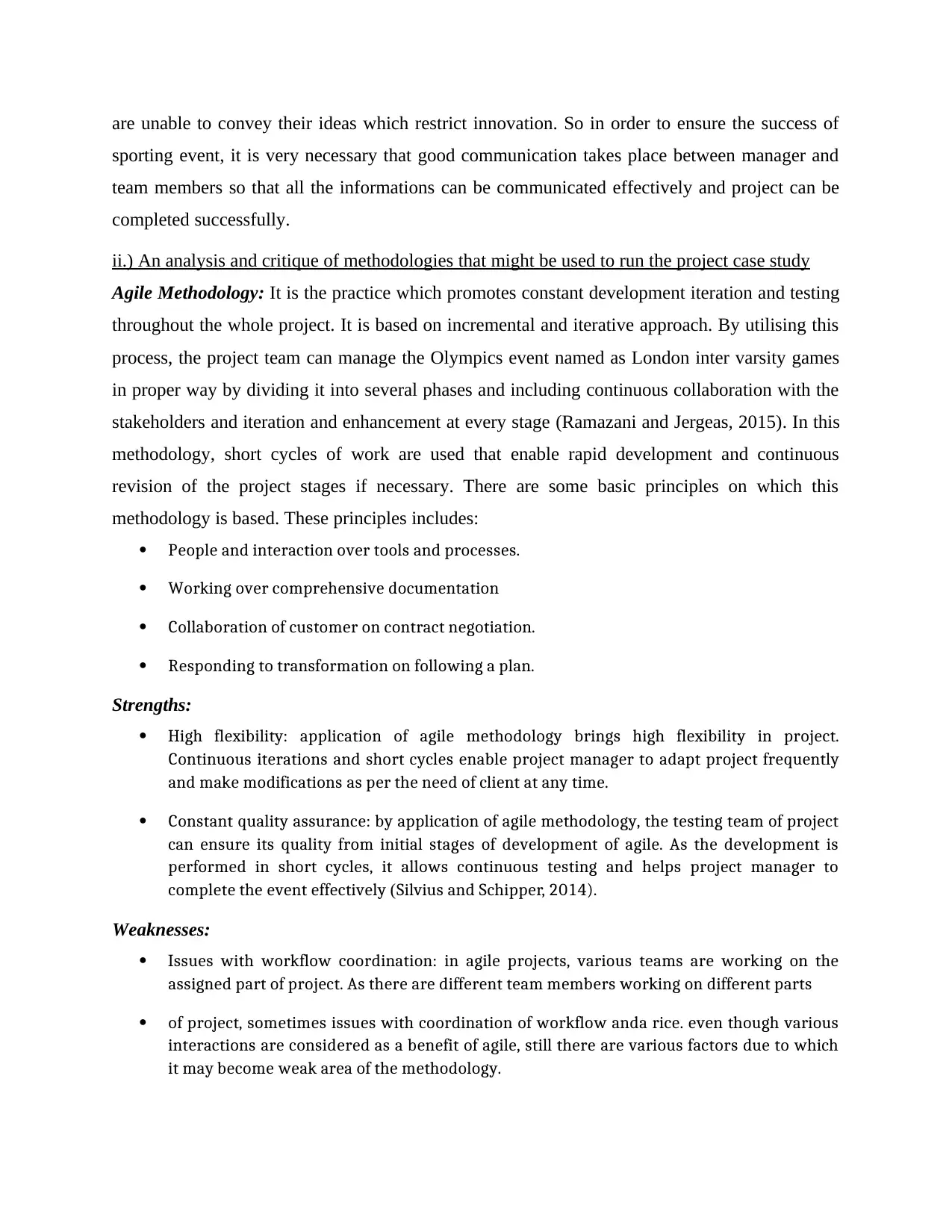
are unable to convey their ideas which restrict innovation. So in order to ensure the success of
sporting event, it is very necessary that good communication takes place between manager and
team members so that all the informations can be communicated effectively and project can be
completed successfully.
ii.) An analysis and critique of methodologies that might be used to run the project case study
Agile Methodology: It is the practice which promotes constant development iteration and testing
throughout the whole project. It is based on incremental and iterative approach. By utilising this
process, the project team can manage the Olympics event named as London inter varsity games
in proper way by dividing it into several phases and including continuous collaboration with the
stakeholders and iteration and enhancement at every stage (Ramazani and Jergeas, 2015). In this
methodology, short cycles of work are used that enable rapid development and continuous
revision of the project stages if necessary. There are some basic principles on which this
methodology is based. These principles includes:
People and interaction over tools and processes.
Working over comprehensive documentation
Collaboration of customer on contract negotiation.
Responding to transformation on following a plan.
Strengths:
High flexibility: application of agile methodology brings high flexibility in project.
Continuous iterations and short cycles enable project manager to adapt project frequently
and make modifications as per the need of client at any time.
Constant quality assurance: by application of agile methodology, the testing team of project
can ensure its quality from initial stages of development of agile. As the development is
performed in short cycles, it allows continuous testing and helps project manager to
complete the event effectively (Silvius and Schipper, 2014).
Weaknesses:
Issues with workflow coordination: in agile projects, various teams are working on the
assigned part of project. As there are different team members working on different parts
of project, sometimes issues with coordination of workflow anda rice. even though various
interactions are considered as a benefit of agile, still there are various factors due to which
it may become weak area of the methodology.
sporting event, it is very necessary that good communication takes place between manager and
team members so that all the informations can be communicated effectively and project can be
completed successfully.
ii.) An analysis and critique of methodologies that might be used to run the project case study
Agile Methodology: It is the practice which promotes constant development iteration and testing
throughout the whole project. It is based on incremental and iterative approach. By utilising this
process, the project team can manage the Olympics event named as London inter varsity games
in proper way by dividing it into several phases and including continuous collaboration with the
stakeholders and iteration and enhancement at every stage (Ramazani and Jergeas, 2015). In this
methodology, short cycles of work are used that enable rapid development and continuous
revision of the project stages if necessary. There are some basic principles on which this
methodology is based. These principles includes:
People and interaction over tools and processes.
Working over comprehensive documentation
Collaboration of customer on contract negotiation.
Responding to transformation on following a plan.
Strengths:
High flexibility: application of agile methodology brings high flexibility in project.
Continuous iterations and short cycles enable project manager to adapt project frequently
and make modifications as per the need of client at any time.
Constant quality assurance: by application of agile methodology, the testing team of project
can ensure its quality from initial stages of development of agile. As the development is
performed in short cycles, it allows continuous testing and helps project manager to
complete the event effectively (Silvius and Schipper, 2014).
Weaknesses:
Issues with workflow coordination: in agile projects, various teams are working on the
assigned part of project. As there are different team members working on different parts
of project, sometimes issues with coordination of workflow anda rice. even though various
interactions are considered as a benefit of agile, still there are various factors due to which
it may become weak area of the methodology.
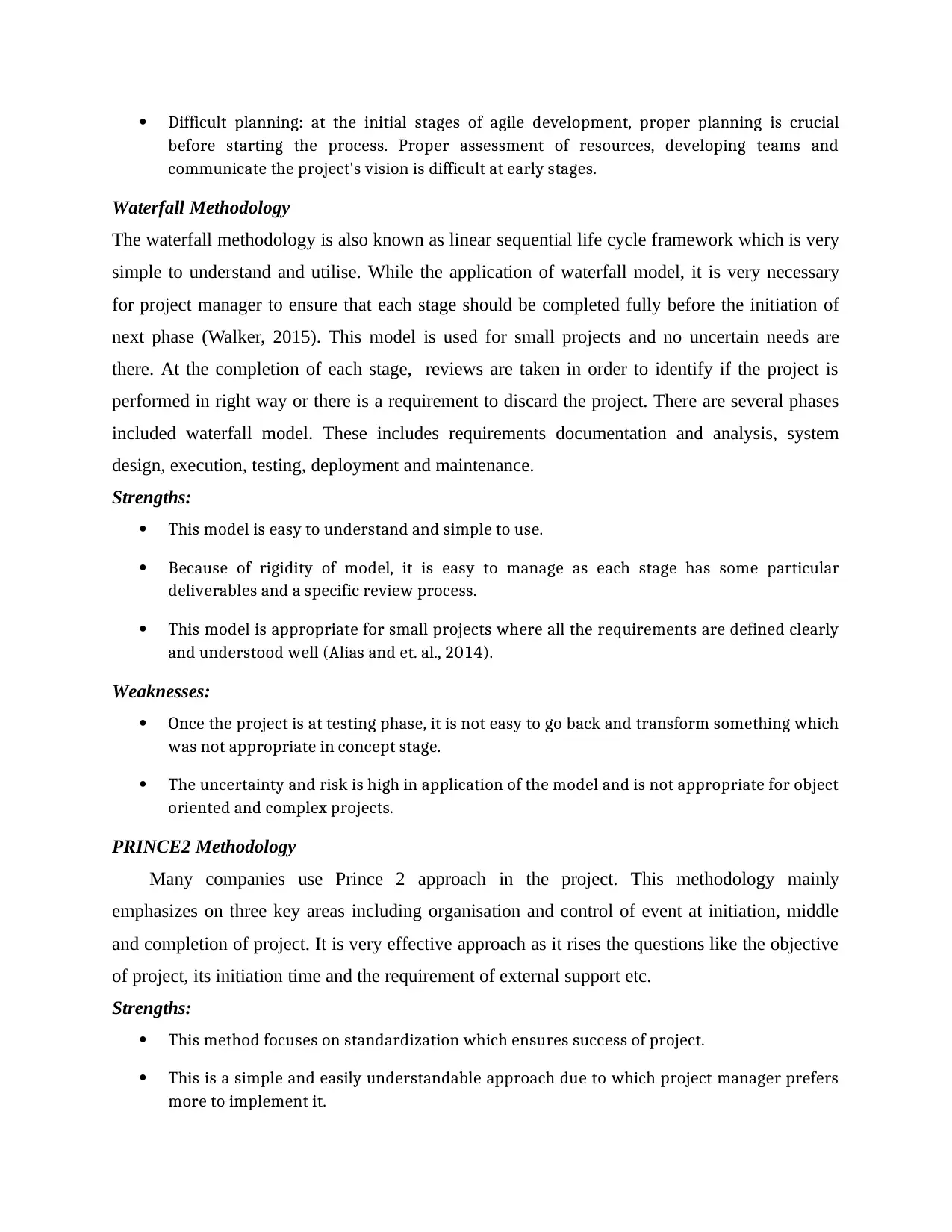
Difficult planning: at the initial stages of agile development, proper planning is crucial
before starting the process. Proper assessment of resources, developing teams and
communicate the project's vision is difficult at early stages.
Waterfall Methodology
The waterfall methodology is also known as linear sequential life cycle framework which is very
simple to understand and utilise. While the application of waterfall model, it is very necessary
for project manager to ensure that each stage should be completed fully before the initiation of
next phase (Walker, 2015). This model is used for small projects and no uncertain needs are
there. At the completion of each stage, reviews are taken in order to identify if the project is
performed in right way or there is a requirement to discard the project. There are several phases
included waterfall model. These includes requirements documentation and analysis, system
design, execution, testing, deployment and maintenance.
Strengths:
This model is easy to understand and simple to use.
Because of rigidity of model, it is easy to manage as each stage has some particular
deliverables and a specific review process.
This model is appropriate for small projects where all the requirements are defined clearly
and understood well (Alias and et. al., 2014).
Weaknesses:
Once the project is at testing phase, it is not easy to go back and transform something which
was not appropriate in concept stage.
The uncertainty and risk is high in application of the model and is not appropriate for object
oriented and complex projects.
PRINCE2 Methodology
Many companies use Prince 2 approach in the project. This methodology mainly
emphasizes on three key areas including organisation and control of event at initiation, middle
and completion of project. It is very effective approach as it rises the questions like the objective
of project, its initiation time and the requirement of external support etc.
Strengths:
This method focuses on standardization which ensures success of project.
This is a simple and easily understandable approach due to which project manager prefers
more to implement it.
before starting the process. Proper assessment of resources, developing teams and
communicate the project's vision is difficult at early stages.
Waterfall Methodology
The waterfall methodology is also known as linear sequential life cycle framework which is very
simple to understand and utilise. While the application of waterfall model, it is very necessary
for project manager to ensure that each stage should be completed fully before the initiation of
next phase (Walker, 2015). This model is used for small projects and no uncertain needs are
there. At the completion of each stage, reviews are taken in order to identify if the project is
performed in right way or there is a requirement to discard the project. There are several phases
included waterfall model. These includes requirements documentation and analysis, system
design, execution, testing, deployment and maintenance.
Strengths:
This model is easy to understand and simple to use.
Because of rigidity of model, it is easy to manage as each stage has some particular
deliverables and a specific review process.
This model is appropriate for small projects where all the requirements are defined clearly
and understood well (Alias and et. al., 2014).
Weaknesses:
Once the project is at testing phase, it is not easy to go back and transform something which
was not appropriate in concept stage.
The uncertainty and risk is high in application of the model and is not appropriate for object
oriented and complex projects.
PRINCE2 Methodology
Many companies use Prince 2 approach in the project. This methodology mainly
emphasizes on three key areas including organisation and control of event at initiation, middle
and completion of project. It is very effective approach as it rises the questions like the objective
of project, its initiation time and the requirement of external support etc.
Strengths:
This method focuses on standardization which ensures success of project.
This is a simple and easily understandable approach due to which project manager prefers
more to implement it.
Secure Best Marks with AI Grader
Need help grading? Try our AI Grader for instant feedback on your assignments.
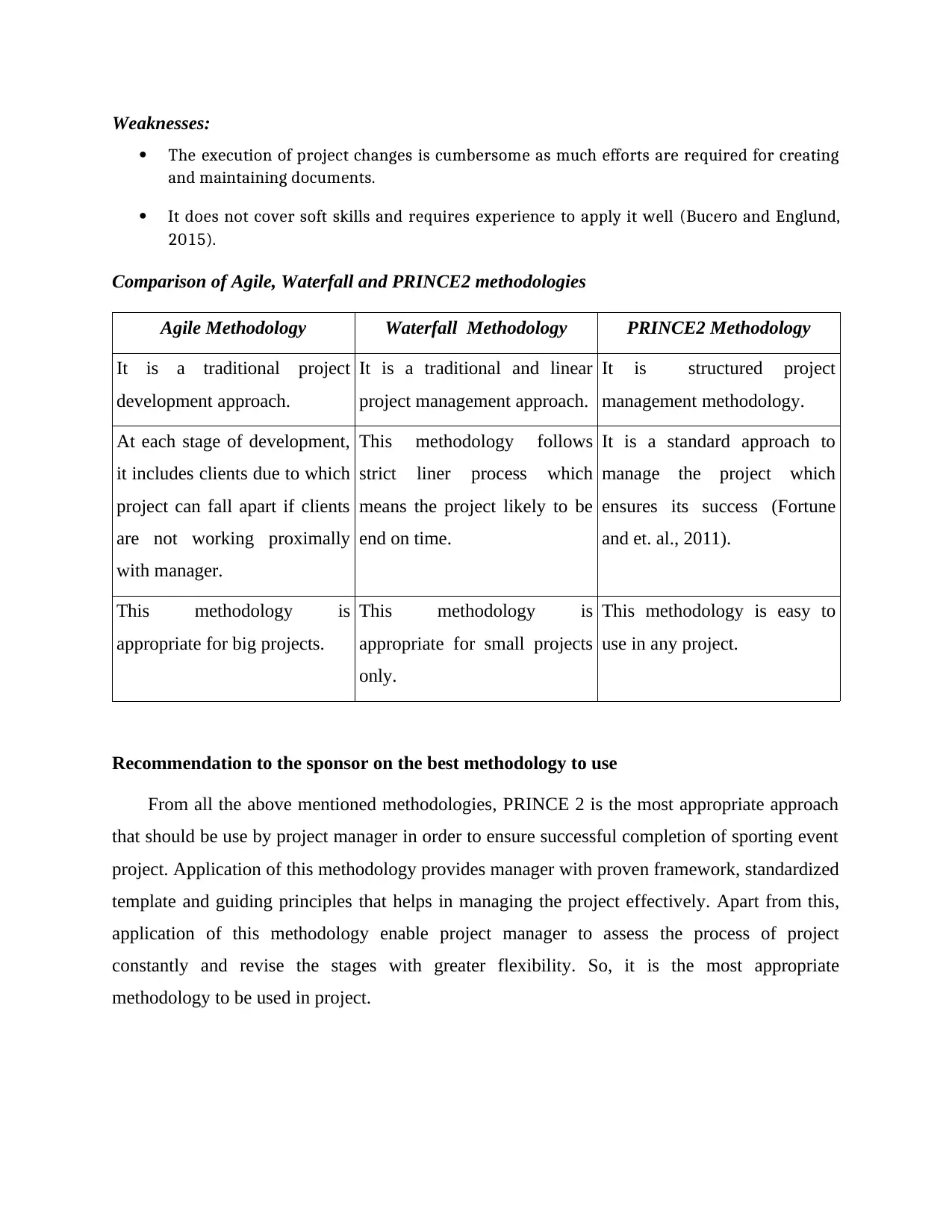
Weaknesses:
The execution of project changes is cumbersome as much efforts are required for creating
and maintaining documents.
It does not cover soft skills and requires experience to apply it well (Bucero and Englund,
2015).
Comparison of Agile, Waterfall and PRINCE2 methodologies
Agile Methodology Waterfall Methodology PRINCE2 Methodology
It is a traditional project
development approach.
It is a traditional and linear
project management approach.
It is structured project
management methodology.
At each stage of development,
it includes clients due to which
project can fall apart if clients
are not working proximally
with manager.
This methodology follows
strict liner process which
means the project likely to be
end on time.
It is a standard approach to
manage the project which
ensures its success (Fortune
and et. al., 2011).
This methodology is
appropriate for big projects.
This methodology is
appropriate for small projects
only.
This methodology is easy to
use in any project.
Recommendation to the sponsor on the best methodology to use
From all the above mentioned methodologies, PRINCE 2 is the most appropriate approach
that should be use by project manager in order to ensure successful completion of sporting event
project. Application of this methodology provides manager with proven framework, standardized
template and guiding principles that helps in managing the project effectively. Apart from this,
application of this methodology enable project manager to assess the process of project
constantly and revise the stages with greater flexibility. So, it is the most appropriate
methodology to be used in project.
The execution of project changes is cumbersome as much efforts are required for creating
and maintaining documents.
It does not cover soft skills and requires experience to apply it well (Bucero and Englund,
2015).
Comparison of Agile, Waterfall and PRINCE2 methodologies
Agile Methodology Waterfall Methodology PRINCE2 Methodology
It is a traditional project
development approach.
It is a traditional and linear
project management approach.
It is structured project
management methodology.
At each stage of development,
it includes clients due to which
project can fall apart if clients
are not working proximally
with manager.
This methodology follows
strict liner process which
means the project likely to be
end on time.
It is a standard approach to
manage the project which
ensures its success (Fortune
and et. al., 2011).
This methodology is
appropriate for big projects.
This methodology is
appropriate for small projects
only.
This methodology is easy to
use in any project.
Recommendation to the sponsor on the best methodology to use
From all the above mentioned methodologies, PRINCE 2 is the most appropriate approach
that should be use by project manager in order to ensure successful completion of sporting event
project. Application of this methodology provides manager with proven framework, standardized
template and guiding principles that helps in managing the project effectively. Apart from this,
application of this methodology enable project manager to assess the process of project
constantly and revise the stages with greater flexibility. So, it is the most appropriate
methodology to be used in project.
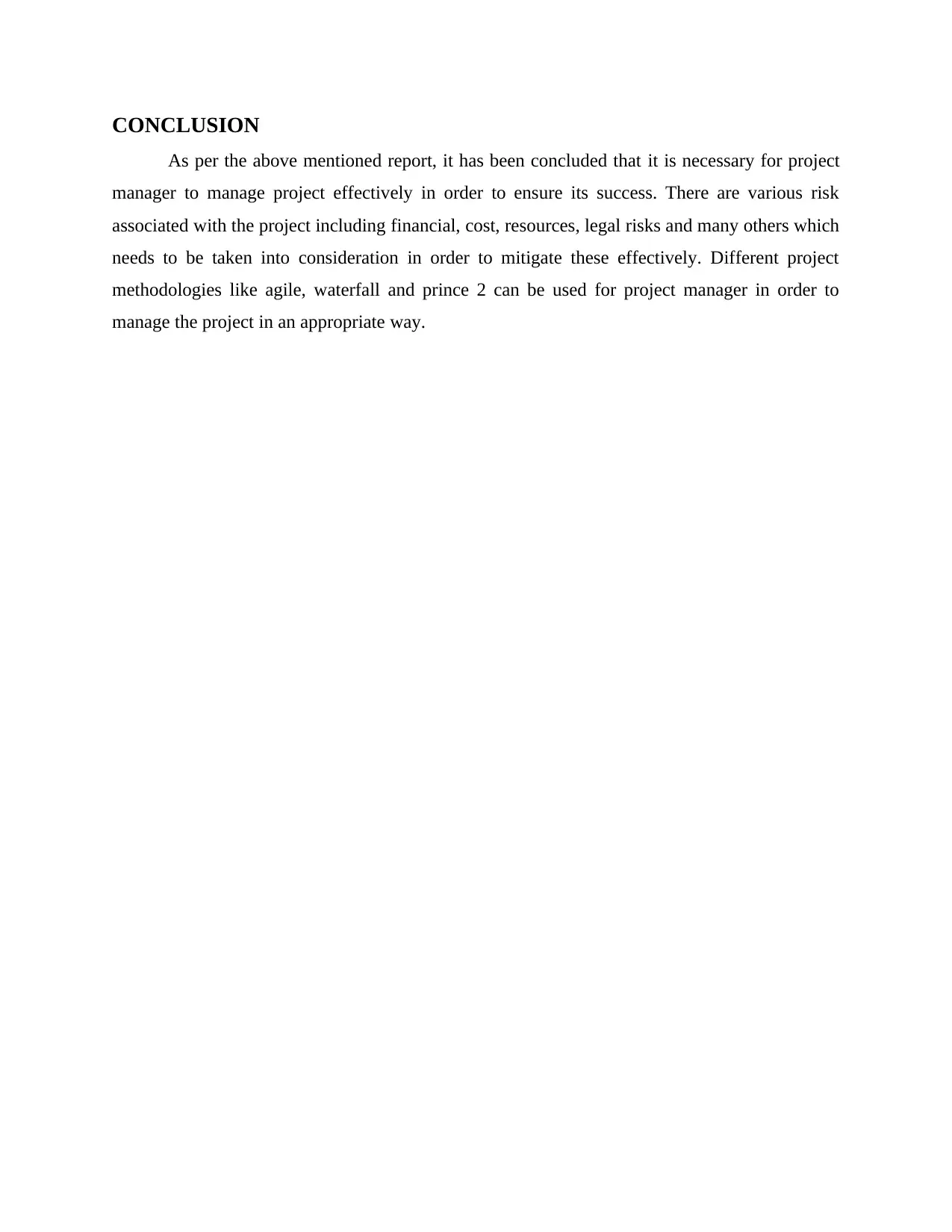
CONCLUSION
As per the above mentioned report, it has been concluded that it is necessary for project
manager to manage project effectively in order to ensure its success. There are various risk
associated with the project including financial, cost, resources, legal risks and many others which
needs to be taken into consideration in order to mitigate these effectively. Different project
methodologies like agile, waterfall and prince 2 can be used for project manager in order to
manage the project in an appropriate way.
As per the above mentioned report, it has been concluded that it is necessary for project
manager to manage project effectively in order to ensure its success. There are various risk
associated with the project including financial, cost, resources, legal risks and many others which
needs to be taken into consideration in order to mitigate these effectively. Different project
methodologies like agile, waterfall and prince 2 can be used for project manager in order to
manage the project in an appropriate way.
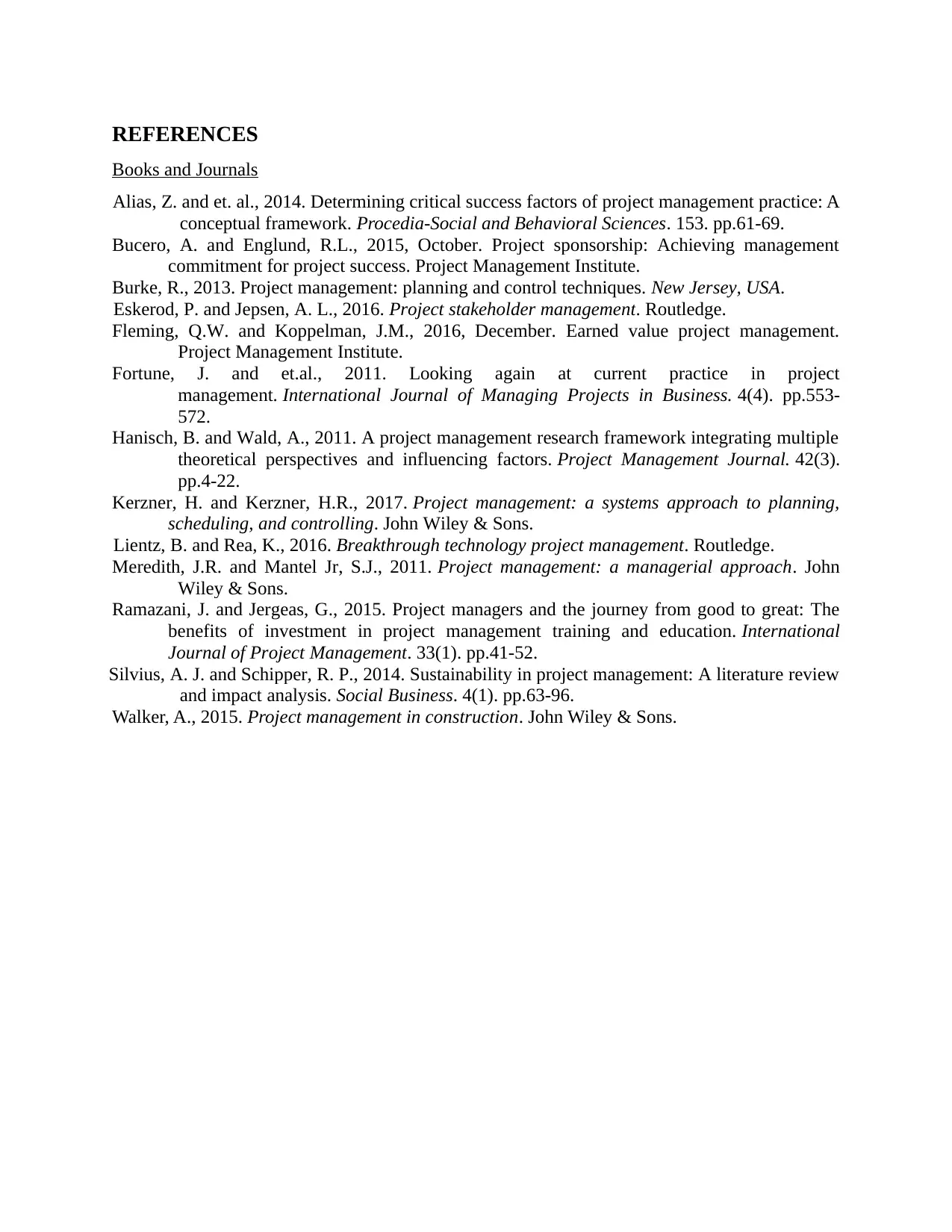
REFERENCES
Books and Journals
Alias, Z. and et. al., 2014. Determining critical success factors of project management practice: A
conceptual framework. Procedia-Social and Behavioral Sciences. 153. pp.61-69.
Bucero, A. and Englund, R.L., 2015, October. Project sponsorship: Achieving management
commitment for project success. Project Management Institute.
Burke, R., 2013. Project management: planning and control techniques. New Jersey, USA.
Eskerod, P. and Jepsen, A. L., 2016. Project stakeholder management. Routledge.
Fleming, Q.W. and Koppelman, J.M., 2016, December. Earned value project management.
Project Management Institute.
Fortune, J. and et.al., 2011. Looking again at current practice in project
management. International Journal of Managing Projects in Business. 4(4). pp.553-
572.
Hanisch, B. and Wald, A., 2011. A project management research framework integrating multiple
theoretical perspectives and influencing factors. Project Management Journal. 42(3).
pp.4-22.
Kerzner, H. and Kerzner, H.R., 2017. Project management: a systems approach to planning,
scheduling, and controlling. John Wiley & Sons.
Lientz, B. and Rea, K., 2016. Breakthrough technology project management. Routledge.
Meredith, J.R. and Mantel Jr, S.J., 2011. Project management: a managerial approach. John
Wiley & Sons.
Ramazani, J. and Jergeas, G., 2015. Project managers and the journey from good to great: The
benefits of investment in project management training and education. International
Journal of Project Management. 33(1). pp.41-52.
Silvius, A. J. and Schipper, R. P., 2014. Sustainability in project management: A literature review
and impact analysis. Social Business. 4(1). pp.63-96.
Walker, A., 2015. Project management in construction. John Wiley & Sons.
Books and Journals
Alias, Z. and et. al., 2014. Determining critical success factors of project management practice: A
conceptual framework. Procedia-Social and Behavioral Sciences. 153. pp.61-69.
Bucero, A. and Englund, R.L., 2015, October. Project sponsorship: Achieving management
commitment for project success. Project Management Institute.
Burke, R., 2013. Project management: planning and control techniques. New Jersey, USA.
Eskerod, P. and Jepsen, A. L., 2016. Project stakeholder management. Routledge.
Fleming, Q.W. and Koppelman, J.M., 2016, December. Earned value project management.
Project Management Institute.
Fortune, J. and et.al., 2011. Looking again at current practice in project
management. International Journal of Managing Projects in Business. 4(4). pp.553-
572.
Hanisch, B. and Wald, A., 2011. A project management research framework integrating multiple
theoretical perspectives and influencing factors. Project Management Journal. 42(3).
pp.4-22.
Kerzner, H. and Kerzner, H.R., 2017. Project management: a systems approach to planning,
scheduling, and controlling. John Wiley & Sons.
Lientz, B. and Rea, K., 2016. Breakthrough technology project management. Routledge.
Meredith, J.R. and Mantel Jr, S.J., 2011. Project management: a managerial approach. John
Wiley & Sons.
Ramazani, J. and Jergeas, G., 2015. Project managers and the journey from good to great: The
benefits of investment in project management training and education. International
Journal of Project Management. 33(1). pp.41-52.
Silvius, A. J. and Schipper, R. P., 2014. Sustainability in project management: A literature review
and impact analysis. Social Business. 4(1). pp.63-96.
Walker, A., 2015. Project management in construction. John Wiley & Sons.
1 out of 13
Related Documents
Your All-in-One AI-Powered Toolkit for Academic Success.
+13062052269
info@desklib.com
Available 24*7 on WhatsApp / Email
![[object Object]](/_next/static/media/star-bottom.7253800d.svg)
Unlock your academic potential
© 2024 | Zucol Services PVT LTD | All rights reserved.





